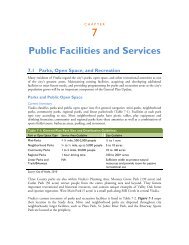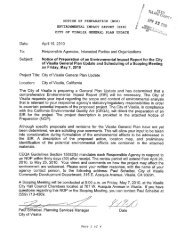General Plan Update Review Committee Draft Elements Part 2 For ...
General Plan Update Review Committee Draft Elements Part 2 For ...
General Plan Update Review Committee Draft Elements Part 2 For ...
You also want an ePaper? Increase the reach of your titles
YUMPU automatically turns print PDFs into web optimized ePapers that Google loves.
Mineral Resources<br />
The most economically significant mineral resources<br />
in Tulare County are sand, gravel, and crushed stone,<br />
used as sources for aggregate (road materials and<br />
other construction). The two major sources of aggregate<br />
are alluvial deposits (river beds, and floodplains),<br />
and hard rock quarries. Consequently, most Tulare<br />
County mines are located along rivers at the base of<br />
the Sierra foothills.<br />
Surface mining in California is regulated through the<br />
Surface Mining and Reclamation Act (SMARA), a<br />
State law adopted in 1975 to address the dual goals<br />
of protecting the state’s need for a continuing supply<br />
of mineral resources, while protecting public and<br />
environmental health. SMARA mandates that land<br />
be reclaimed after mining has ceased. Reclamation<br />
plans often restore land for agricultural uses or as<br />
wildlife habitat.<br />
SMARA requires that all cities incorporate into their<br />
general plans mapped mineral resource designations<br />
approved by the State Mining and Geology Board.<br />
The Visalia <strong>Plan</strong>ning Area contains three former sand<br />
and gravel mines, but no currently operating mines<br />
and no designated Mineral Resource Zones.<br />
Objectives<br />
OSC-O-9 Protect agricultural land from premature<br />
urban development.<br />
Policies<br />
OSC-P-24 Work with Tulare County to prevent urban<br />
development of agricultural land outside of<br />
the current Urban Development Boundary<br />
and to promote the of use agricultural<br />
preserves, where they will promote orderly<br />
development.<br />
Note: this policy is in the <strong>Draft</strong> Land Use<br />
Element, and will be removed there if it is<br />
preferred here.<br />
OSC-P-25 *Adopt the County’s Right-to-Farm ordinance<br />
to support continued agricultural<br />
operations at appropriate locations within<br />
the City limits, with no new provisions.<br />
This ordinance should not limit urban development<br />
contemplated by the <strong>General</strong> <strong>Plan</strong>.<br />
OSC-P-26 Note: this policy is in the <strong>Draft</strong> Land Use<br />
Element, and will be removed there if it is<br />
preferred here. *Adopt an Urban Agriculture<br />
Ordinance, reflecting “best practices,”<br />
to support community gardens and other<br />
activities.<br />
This ordinance will be prepared in consultation<br />
with the Farm Bureau and other interested<br />
organizations and individuals.<br />
OSC-P-27 Note: this policy is in the <strong>Draft</strong> Land Use<br />
Element, and will be removed there if it is<br />
preferred here. To allow efficient cultivation,<br />
pest control and harvesting methods,<br />
require buffers and transition areas<br />
between urban development and adjoining<br />
or nearby agricultural land.<br />
OSC-P-28 Require new development to implement<br />
measures, as appropriate, to minimize soil<br />
erosion related to grading, site preparation,<br />
landscaping and construction.<br />
DRAFT ELEMENTS<br />
<strong>For</strong> <strong>General</strong> <strong>Plan</strong> <strong>Update</strong> <strong>Review</strong> <strong>Committee</strong><br />
AUGUST 2012 6-17




